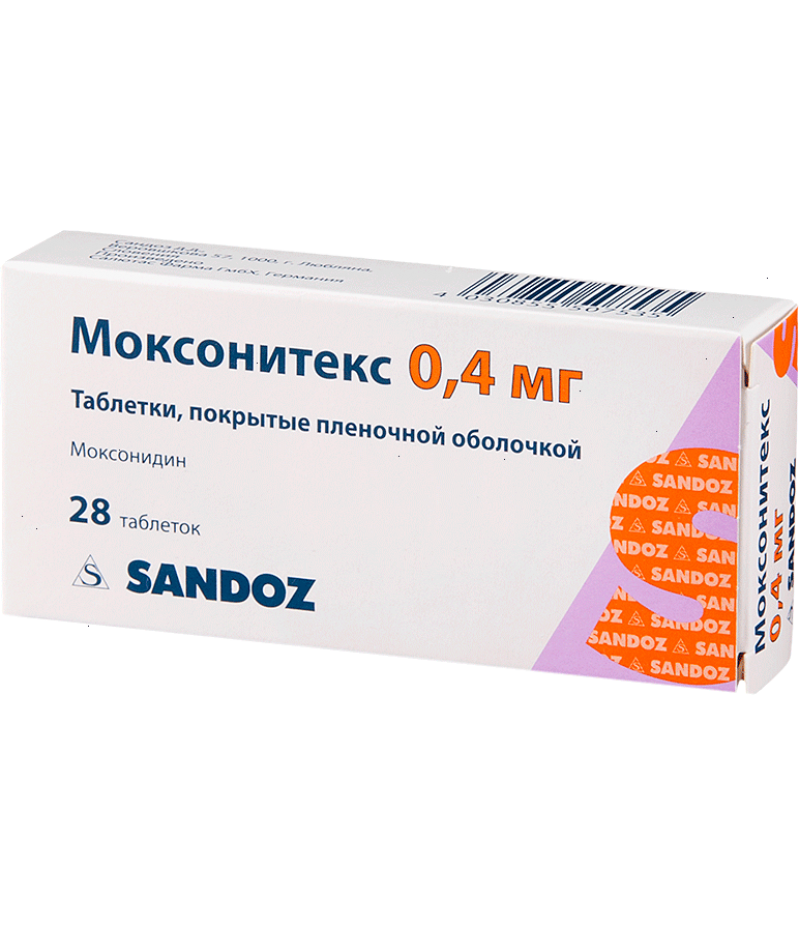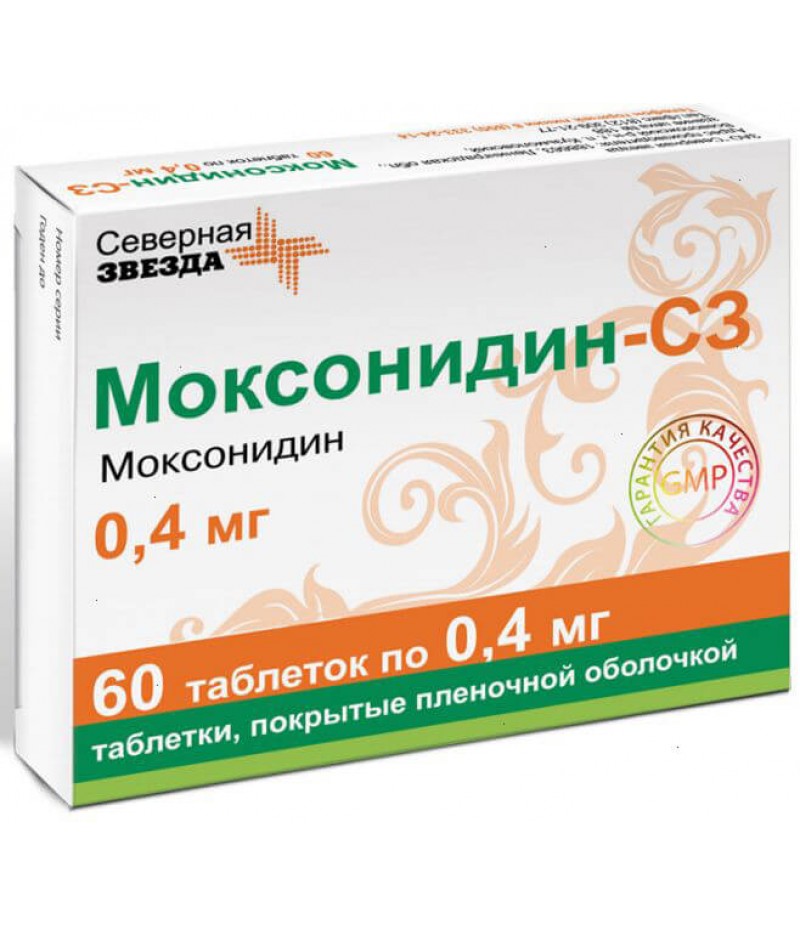Moxarel tabs 0.4mg #30
- $23.38
- 3 or more $23.15
- Availability:In Stock
Moxarel instruction for useYou can buy Moxarel hereComposition1 tablet contains:Active ingredient: moxonidine;Excipients: lactose monohydrate; MCC; colloidal silicon dioxide; Povidone K30; croscarmellose sodium; magnesium stearate..
Tags: tabs
Moxarel instruction for use
You can buy Moxarel here
Composition
1 tablet contains:
Active ingredient: moxonidine;
Excipients: lactose monohydrate; MCC; colloidal silicon dioxide; Povidone K30; croscarmellose sodium; magnesium stearate.
Packaging - 30 pieces
pharmachologic effect
Moxarel - hypotensive.
Pharmacodynamics
Moxonidine is a hypotensive agent with a central mechanism of action. In the brain stem structures (rostral layer of the lateral ventricles), moxonidine selectively stimulates imidazolin-sensitive receptors that are involved in the tonic and reflex regulation of the sympathetic nervous system. Stimulation of the imidazoline receptor decreases peripheral sympathetic activity and blood pressure.
Moxonidine differs from other adrenergic antihypertensive drugs by its lower affinity for α1 -adrenoreceptors, which explains the lower likelihood of developing a sedative effect and dryness of the oral mucosa.
Acceptance of moxonidine leads to a decrease in systemic vascular resistance and blood pressure.
Moxonidine improves insulin sensitivity index in patients with obesity, insulin resistance, and moderate hypertension.
Pharmacokinetics
Suction. After oral administration, moxonidine is rapidly and almost completely absorbed in the upper GI tract. Absolute bioavailability is approximately 88%. Tmax - about 1 hour. Eating does not affect the pharmacokinetics of the drug.
Distribution. Communication with plasma proteins is 7.2%.
Metabolism. The main metabolite is dehydrated moxonidine. The pharmacodynamic activity of dehydrated moxonidine is about 10% compared with moxonidine.
Inference. T1 / 2 of moxonidine and metabolite is 2.5 and 5 hours, respectively. Within 24 hours, more than 90% of moxonidine is excreted by the kidneys (about 78% unchanged and 13% in the form of dehydromoxonidine, other metabolites in the urine do not exceed 8% of the accepted dose). Less than 1% of the dose is excreted through the intestines.
Special patient groups
Elderly patients. Clinically insignificant changes in the pharmacokinetic parameters of moxonidine in elderly patients are noted, probably due to a decrease in the intensity of its metabolism and / or slightly higher bioavailability.
Children. Moxonidine is not recommended for use in patients younger than 18 years, and therefore in this group pharmacokinetic studies have not been conducted.
Impaired renal function. Moxonidine clearance is significantly correlated with creatinine clearance. In patients with moderate renal insufficiency (Cl creatinine 30–60 ml / min), plasma Css and end T1 / 2 are approximately 2 and 1.5 times higher than in patients with normal renal function (Cl creatinine more than 90 ml / min ). In patients with severe renal insufficiency (Cl creatinine less than 30 ml / min), plasma Css and end T1 / 2 are 3 times higher than in patients with normal renal function. The administration of multiple doses of moxonidine leads to predictable cumulation in the body of patients with moderate to severe renal failure. In patients with terminal renal failure (Cl creatinine less than 10 ml / min) on hemodialysis, plasma Css and end T1 / 2 are 6 and 4 times higher, respectively, than in patients with normal renal function.
In all groups, the maximum plasma concentration of moxonidine is 1.5–2 times higher. In patients with impaired renal function, the dosage should be adjusted individually. Moxonidine is slightly excreted during hemodialysis.
Indications for use
Arterial hypertension.
Contraindications for Moxarel
hypersensitivity to the active substance, other components of the drug;
marked cardiac arrhythmias;
sick sinus syndrome;
AV block II and III degree;
severe bradycardia (heart rate less than 50 beats / min);
acute and chronic heart failure (NYHA Class III – IV functional class);
simultaneous use with tricyclic antidepressants (see. "Interaction");
severe renal impairment (Cl creatinine less than 30 ml / min), including patients on hemodialysis;
lactose intolerance, lactase deficiency, glucose-galactose malabsorption;
breastfeeding period;
patients older than 75 years;
age up to 18 years (efficacy and safety of moxonidine not established).
With care: renal dysfunction (Cl creatinine more than 30 ml / min); severe hepatic impairment (more than 9 points according to Child-Pugh classification); AV blockade I degree; severe coronary artery disease; severe ischemic heart disease or unstable angina (experience of use is insufficient); chronic heart failure.
Dosage and administration
Inside, regardless of the meal.
In most cases, the initial dose of Moxarel is 0.2 mg / day. The maximum single dose is 0.4 mg. The maximum daily dose, which should be divided into 2 doses, is 0.6 mg. The initial dose for patients with moderate or severe renal insufficiency, as well as for patients on hemodialysis, is 0.2 mg / day. If necessary and with good tolerance, the daily dose may be increased to 0.4 mg.
Use during pregnancy and lactation
Clinical data on the treatment of pregnant women with Moxarel are not available.
Moxarel should be prescribed to pregnant women with caution only after a thorough assessment of the risk-benefit ratio, when the benefit to the mother outweighs the potential risk to the fetus.
Moxonidine passes into breast milk. It is recommended that nursing women stop breastfeeding or stop the drug during the treatment period.
Side effects of Moxarel
From the side of the central nervous system: often - headache, dizziness (vertigo), drowsiness; infrequently - fainting.
On the part of the cardiovascular system: infrequently - pronounced decrease in blood pressure, orthostatic hypotension, bradycardia.
On the part of the digestive tract: very often - dryness of the oral mucosa; often - nausea, diarrhea, vomiting, dyspepsia.
From the skin and subcutaneous tissues: often - skin rash, itching; infrequently - angioedema.
Mental disorders: often - insomnia; infrequently - nervousness.
On the part of the organ of hearing and labyrinth disorders: infrequently - ringing in the ears.
On the part of the musculoskeletal and connective tissues: often - back pain; infrequently - pain in the neck.
General disorders and disorders at the injection site: often asthenia; infrequently - peripheral edema.
special instructions
Currently, there is no evidence that discontinuation of the drug Moxarel leads to an increase in blood pressure. However, it is not recommended to stop taking Moxarel abruptly, instead, you should gradually reduce the dose of the drug for 2 weeks.
If it is necessary to cancel simultaneously taken β-adrenoblockers and Moxarel, first cancel β-adrenergic blockers and only after a few days moxonidine.
During treatment, regular monitoring of blood pressure, heart rate and ECG registration is necessary. It is necessary to stop reception of the drug Moxarel gradually.
During treatment by the drug Moxarel it is necessary to exclude alcohol intake.
Influence on ability to steer vehicles and work with mechanisms. The effect of Moxarel on the ability to drive a vehicle or control equipment has not been studied. However, taking into account the possible occurrence of dizziness and drowsiness, patients should use caution when engaging in potentially hazardous activities that require increased attention, such as driving a vehicle or operating machinery.
Interaction
The combined use of moxonidine with other antihypertensive drugs leads to an additive effect.
Tricyclic antidepressants can reduce the effectiveness of centrally acting antihypertensive drugs, and therefore they are not recommended in conjunction with moxonidine.
Moxonidine can enhance the action of tricyclic antidepressants, tranquilizers, ethanol, sedatives and hypnotics.
Moxonidine can moderately improve impaired cognitive function in patients receiving lorazepam.
Appointment of moxonidine in conjunction with benzodiazepine derivatives may be accompanied by increased sedative effect of the latter.
The simultaneous use of moxonidine with β-adrenergic blockers leads to increased bradycardia, severity of foreign and dromotropic action.
In the appointment of moxonidine in conjunction with moclobemide pharmacodynamic interaction is absent. Moxonidine is secreted by tubular secretion, so its interaction with other drugs secreted by tubular secretion is not excluded.
Overdose
Symptoms: headache, sedation, drowsiness, marked decrease in blood pressure, dizziness, fatigue, asthenia, bradycardia, dryness of the oral mucosa, vomiting and pain in the epigastric region, respiratory depression, impaired consciousness. Short-term increases in blood pressure, tachycardia, and hyperglycemia are also potential.
Treatment: the specific antidote of the drug does not exist. In the case of a pronounced decrease in AD, the introduction of a fluid to restore BCC and dopamine is recommended. Bradycardia can be stopped by atropine. Α-adrenoreceptor antagonists can reduce or eliminate the paradoxical hypertensive effects of moxonidine overdose. In severe cases of overdose, it is recommended to carefully monitor the disturbance of consciousness and to prevent respiratory depression. Moxonidine is slightly excreted during hemodialysis.
Storage conditions
Shelf life - 3 years
In the dark place at a temperature of no higher than 25 ° C.
Terms of sell
You don't need a prescription to buy Moxarel.



